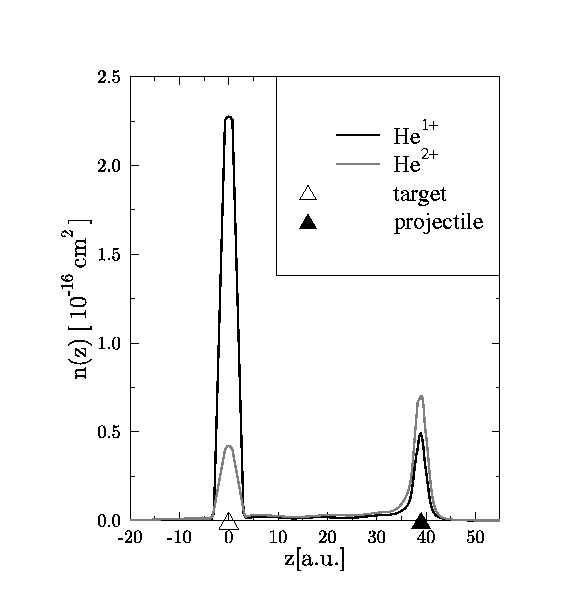
Figure 1:
F9++He: electron emission in coincidence with recoil ion charge.
Theory: integrated distribution of ejected electrons in beam direction.
ECC CUSP AND TWOELECTRON CONTINUA IN HEAVY ION COLLISION
E. Wagner1, H.J. Lüdde1, S. Hagmann2, I. Ali2 and T. Kirchner3
1 Institut für Theoretische Physik, Goethe Universität, D60054 Frankfurt, Germany
2 J.R.Macdonald Laboratory, Dept of Physics, Kansas State University, Manhattan, Ks 66506, USA
3 Department of Physics and Astronomy, York University, Toronto, Ontario, Canada M3J 1P3
We have measured doubly differential cross sections for continuum electron emission induced by I23+ and F8,9+ projectiles in collision with He. We find that the ECC (Electron Capture to the Continuum) coincident with He2+ surprisingly exhibits a larger cross section than the ECC coincident with He+ . A strong forward backward asymmetry is observed in the ECC Cusp coincident with double ionization; electrons with velocities above the projectile velocity appear enhanced above the cross section for electrons coincident with single ionization while the emission cross section for electrons with velocities below the projectile velocity is strongly attenuated.
These experimental results are in accordance with model calculations for F9++He based on a Hartree Fock picture of the two electron problem. Assuming straight line trajectories for the nuclear motion the resulting timedependent singleparticle Schrödinger equation is solved within the basis generator method1, which provides a dynamic and symmetry adapted set of basis functions applicable in a large energy domain2,3. The relevant observable, i.e. the electron emission probability associated with the recoiling ion charge, can be directly extracted from the oneparticle density.
The figure shows the longitudinal probability distribution in configuration space for electron emission in coincidence with He+ and He2+ ions, respectively. The two processes exhibit entirely different signatures: while electron emission associated with singly charged He ions is characterized by a strong target cusp corresponding to relatively small electron velocities, the twoelectron process is dominated by ECC. The model calculation shows that the ECC process appears mainly at small impact parameters while the target cusp is associated with distant collisions. Further details concerning the ECC process will be given at the conference.
Figures:

Figure 1:
F9++He: electron emission in coincidence with recoil ion charge.
Theory: integrated distribution of ejected electrons in beam direction.
References:
1) O.J. Kroneisen, H.J. Lüdde, T. Kirchner and R.M. Dreizler, J. Phys. A 32, 2141 (1999)
2) T.Kirchner, M. Horbatsch, H.J. Lüdde and R.M. Dreizler, Phys. Rev. A 62, 042704 (2000)
3) T.Kirchner, H.J. Lüdde, M. Horbatsch and R.M. Dreizler, Phys. Rev. A 61, 052710 (2000)
This work was supported by the
Chemical Sciences, Geosciences and Biosciences Division,
Office of Basic Energy Sciences,
Office of Science,
U.S. Department of Energy.
Submitted to ICPEAC 2001, July 2001 in Santa Fe, NM.
This abstract is also available in Postscript or Adobe Acrobat formats.
|
|